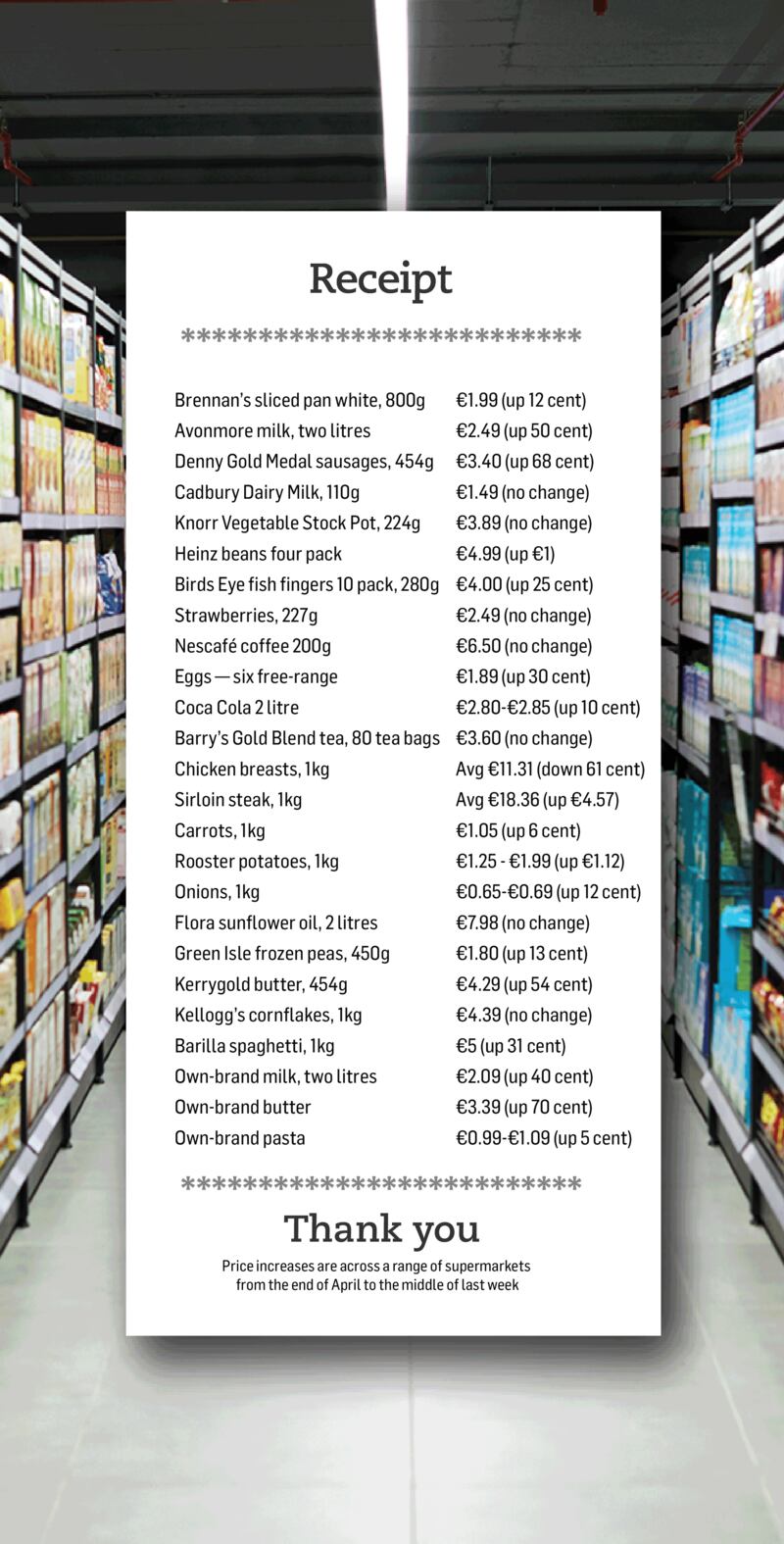The good news is there might just be a pause in the grocery price hikes of recent months coming as retailers and suppliers lock themselves into long-term contracts that factor in the Ukraine war and spiralling cost of energy, flour, cooking oil, motor fuel and everything else that has put pressure on prices up and down the supply chain.
The bad news, however, is that price increases already imposed are likely to be part of a “new normal” with the annual cost of a basket of just 25 commonly bought items now almost €1,000 dearer than last April.
Last week, figures from the Central Statistics Office (CSO) painted a bleak picture for Irish food shoppers with the top line suggesting food prices have climbed by just over 10 per cent in the last 12 months. The picture is even bleaker for many staples. Pasta is up by almost 22 per cent, milk is up by just under 24 per cent, butter is up by more than 20 per cent, beef, pork and chicken are all up by well over 10 per cent.

The most recent grocery price figures from retail analysts Kantar suggest the average annual cost of grocery shopping will cost an additional €868 assuming shoppers buy the same products with the average annual grocery bill now close to €8,000 as grocery price inflation hit 12.4 per cent in the 12 weeks to October 3rd, the highest percentage on record.
READ MORE
Depressingly, Kantar found that one-third of Irish shoppers are “struggling” to make ends meet today compared to still high 23 per cent in March.
[ Food shopping, rent and bills huge concerns among young and oldOpens in new window ]
‘A life with dignity’
Many of those struggling are earning less than the “living wage”, the hourly rate a person needs to have the “minimum required to meet physical, social and psychological needs, and enable a life with dignity” according to the Vincentian MESL Research Centre, an offshoot of the St Vincent de Paul.
This week it published research putting the Living Wage at €13.85 per hour, up 95 cent on last year’s figure and substantially more than the minimum wage which stands at €10.50 per hour although it will rise to €11.30 next year.
“There is always a lag between the available data and the here and now and our research is based on the costs we saw in the first half of the year,” says the group’s research manager Robert Thornton. “But since then inflation has been extraordinary and grocery prices have kept climbing so if we were to base our Living Wage on today’s prices it would be even higher.”
One possible positive is to be found in the contracts retailers hammer out with suppliers. TU Dublin academic and retail expert Damian O’Reilly believes many long-term arrangements are now in place and take into account dramatically higher input costs.
“It takes time for these costs to feed into the system but they are there now so I think we might be hitting peak inflation,” he suggests. “While I wouldn’t say we are over the worst of the cost of living crisis, the higher costs of recent months are now factored into the supply chain and I don’t think prices will go up significantly over the next six months.”

Sean O’Driscoll of Cliste Hospitality: 'There were a number of hoteliers charging rates that were indefensible'
He says that unlike other retail sectors, grocery tends to be predictable. “If a retailer sells 1,000 tins of beans in one month, they can be pretty sure they will sell 1,000 tins of beans in the same month the next year. That means that sales forecasts are more easily factored into long-term contracts and I think what we are going to see in the months ahead is a new normal.”
While the new normal is depressing, O’Reilly says it is worth looking at current pricing through a wider prism. “Prices today are still 1.5 per cent lower than they were in 2011. I don’t think people realise that for a decade we have had this price compression as a result of discounts and supply chains getting very efficient. That has changed now.”
Food-price pressure
Thornton is pessimistic as to what the new normal might mean for hundreds of thousands of people. “While food isn’t the biggest component of price increases, it is not an optional thing,” he notes. “It makes up so much more of a person on a low income’s weekly spending and even if pressure on food prices eases off, no one is suggesting they will return to where they were which will leave more people faced with the choice of heat or eat.”
In recent months The Irish Times has charted shifts in the price of 25 commonly bought products. Since we began doing so at the end of April, just one of the products has fallen in price, a handful has remained at the same price and the vast majority have climbed in price.
The basket of goods that cost €84.88 at the end of April cost €102.38 at the end of the week just past, a rise of €17.50
Spread out over the course of a full year and the higher cost of those items — just a small percentage of the typical weekly shop — will climb by more than €910.
We will check on these items next month to get a sense of how they are moving and what impact that will have on our pockets. If you notice any big price increases, let us know at pricewatch@irishtimes.com.
















